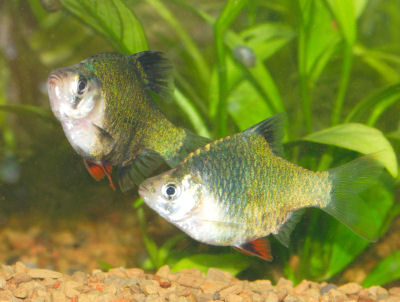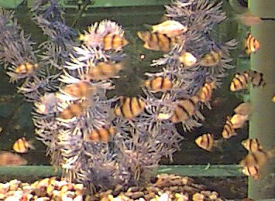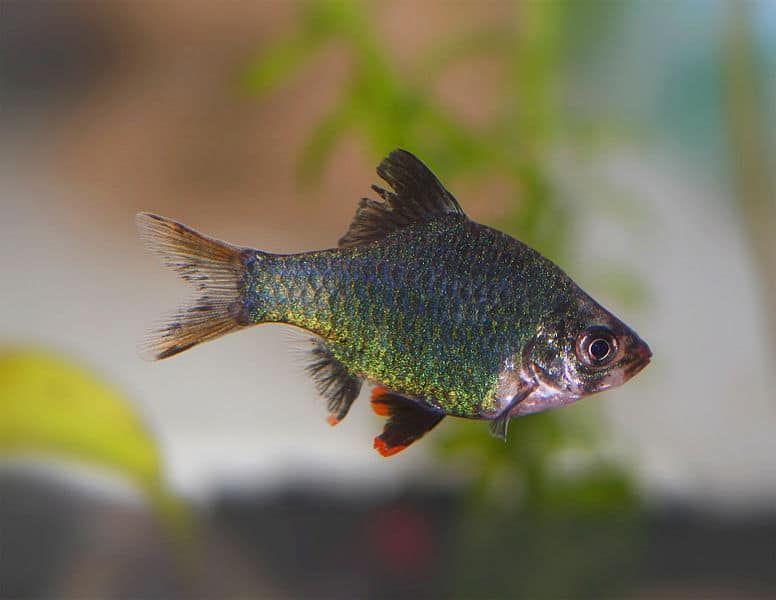
The Green Tiger Barb is a very lively fish and one of the most striking Tiger Barb varieties!
The commonly available and popular Green Tiger Barb is one of the most notable color morphs of the Tiger BarbPuntius tetrazona. This variety is truly striking with its deep fluorescent green or blue-green body coloring. When mature, its colors do tend to fade a bit, but a school of these playful and attractive fish makes an awesome display in a nice-sized aquarium. Some other common names for this fish are Moss Green Tiger Barb, Green Moss Tiger Barb, Moss-Banded Barb, Moss Barb, Platinum Green Tiger Barb, Moss Green Platinum Tiger Barb, and Blue Tiger Barb.
Like its predecessors, this green variety makes a very good fish for the beginning aquarist and is enjoyed by advanced aquarists as well. Their aquarium needs, care, and feeding are the same as their parentage. They are quite hardy as long as their water is kept clean with regular water changes. They are lively and active so need plenty of room to swim. The aquarium can be planted around the sides and back of the tank to give them lots of open swimming area in the middle.
These very active, fast swimming fish need to be kept in a school. Though they are playful, they can be nippy with their tankmates. These barbs do best in a group of at least 6 or 7 and will establish a “pecking order.” They are most prone to nipping when they are kept individually or in a smaller group. In a larger school, they are too busy chasing each other to bother with their other tankmates. Still, they should not be kept with slow-swimming or long-finned fishes, such as gouramis and angelfish, but will do very well in a community tank with other active species. Kept singly, they can become aggressive.
To create a very attractive effect in your aquarium, try a mixed school by combining the pretty Green Tiger Barbs with some regular Tiger Barbs. A mix like this will provide a nice contrast of swiftly moving, darting color. You can add other varieties as well, including the Longfin Tiger Barb, which was developed for longer finnage, and the Albino Tiger Barb, which has some wonderful red, gold, and platinum strains as well. Mixing more varieties works equally well and creates a really exciting effect.
For more Information on keeping freshwater fish see:
Guide to a Happy, Healthy Freshwater Aquarium
- Kingdom: Animalia
- Phylum: Chordata
- Class: Actinopterygii
- Order: Cypriniformes
- Family: Cyprinidae
- Genus: Puntius
- Species: tetrazona
- Aquarist Experience Level: Beginner
- Size of fish – inches: 2.8 inches (6.99 cm)
- Minimum Tank Size: 15 gal (57 L)
- Temperament: Semi-aggressive
- Aquarium Hardiness: Very Hardy
- Temperature: 68.0 to 79.0° F (20.0 to 26.1° C)
- My Aquarium – Enter your aquarium to see if this fish is compatible!
- Beginner Fish – Freshwater fish for beginners
- Community Fish – Peaceful Freshwater fish
- Hardy Fish – Hardy Freshwater fish
- Similar size fish – Fish that are 1 inch bigger or smaller
- Coldwater Fish – Looking for cold water fish? (65 °)
Habitat: Distribution / Background
The Tiger Barb Puntius tetrazona (previously Barbus tetrazona) was described by Bleeker in 1855. They are found throughout the Malay Peninsula, Sumatra, Borneo, and possibly Thailand and Cambodia. They are native to the island of Borneo and found in both the Malaysian state of Sarawak and Kalimantan, the Indonesian part of the island. Feral populations have been introduced to Singapore, Australia, the United States, and Colombia.
This fish prefers quiet forest streams and tributaries with clear, highly oxygenated waters. The substrate is normally composed of sand and rocks and grows very dense vegetation. In nature, this fish feeds on insects, diatoms, algae, small invertebrates, and detritus.
The Green Tiger Barb is a captive-bred color morph developed from the Tiger Barb. Many of these barbs are captive-bred for the aquarium industry. Other common names they are known by include Moss Barb, Moss Green Tiger Barb, Green Moss Tiger Barb, Moss-Banded Barb, Platinum Green Tiger Barb, Moss Green Platinum Tiger Barb, and Blue Tiger Barb. There are no wild populations of these color morphs.
- Scientific Name: Puntius tetrazona
- Social Grouping: Groups
- IUCN Red List: NE – Not Evaluated or not listed – There are no wild populations of this color morph.
Description
The Green Tiger Barb has a round, deep body with a high back and a pointed head. These small fish reach lengths of only up to about 2 3/4 inches (7 cm) in the wild but are generally a bit smaller in the aquarium. They have a lifespan of 6 to 7 years with proper care.
The body coloration is a truly striking, deep fluorescent green or metallic blue-green. The four very distinctive black stripes in the parent Tiger Barbs are missing. There is red on the outside of the dorsal fins as well as on the tail and ventral fins. When spawning, they have a bright red snout.
- Size of fish – inches: 2.8 inches (6.99 cm)
- Lifespan: 7 years
Fish Keeping Difficulty
The Green Tiger Bar is a very hardy fish and a great choice for beginning aquarists. They are usually not very picky eaters and will take and thrive on quality flake foods. As with any inbred fish, they can be a bit weaker then the fish they originate from. Their tank does need to be kept clean as they are susceptible to ich. With clean, clear, well-filtered water, these fish will do very well. Use caution picking their tankmates as they will nip the fins of slow-swimming and long-finned fish.
- Aquarium Hardiness: Very Hardy
- Aquarist Experience Level: Beginner
Foods and Feeding
Since they are omnivorous, the Green Tiger Barb will generally eat all kinds of live, fresh, and flake foods. To keep a good balance, give them a high quality flake food every day. Feed brine shrimp (either live or frozen) or blood worms as a treat. This fish will eat as much as is offered, so be sure to determine a reasonable amount. The rule of thumb when feeding several times a day is to offer only what they can consume in 3 minutes or less at each feeding. When offering food just once a day, provide what they can eat in about 5 minutes.
- Diet Type: Omnivore
- Flake Food: Yes
- Tablet / Pellet: Yes
- Live foods (fishes, shrimps, worms): Some of Diet
- Vegetable Food: Some of Diet
- Meaty Food: Some of Diet
- Feeding Frequency: Several feedings per day – Offer only what they can consume in 3 minutes or less with multiple feedings per day.
Aquarium Care
These Barbs are not exceptionally difficult to care for provided their water is kept clean. Aquariums are closed systems, and regardless of size, all need some maintenance. Over time, decomposing organic matter, nitrates, and phosphate build up, and water hardness increases due to evaporation. Replace 25 to 50% of the tank water at least once a month. If the tank is densely stocked, 20 to 25% should be replaced weekly or every other week.
- Water Changes: Monthly – If the tank is densely stocked, water changes should be done every other week.
Aquarium Setup
Green Tiger Barbs will swim in all parts of the tank but prefer open areas in the middle. Since their maximum size is less than 3 inches, a school will need at least a 15-gallon aquarium. However, because they are very active swimmers, they will do much better in a tank that is 30 inches long and 30 gallons or more. Provide good filtration and do regular water changes. Additionally, the tank should be covered as these fish may jump.
These fish will do best and are most effectively displayed in tanks that simulate their natural habitat. As with most barb species, they are most at home in well planted aquariums and need plenty of open swimming areas. Use lots of plants, a sandy substrate, and bog wood decor to echo their native habitat. An efficient filter and good water movement are needed for the males to develop their coloration.
- Minimum Tank Size: 15 gal (57 L)
- Suitable for Nano Tank: Yes
- Substrate Type: Any
- Lighting Needs: Moderate – normal lighting
- Temperature: 68.0 to 79.0° F (20.0 to 26.1° C)
- Breeding Temperature: – Breeding temperatures between 74 and 79° F (24 – 26° C).
- Range ph: 6.5-7.5 – Hobbyists intending to breed their stock should keep the water more acidic (closer to 6.5).
- Hardness Range: 2 – 30 dGH
- Brackish: No
- Water Movement: Moderate
- Water Region: All – These fish will swim in all areas of the aquarium, but they prefer the middle.
Social Behaviors
The lively Green Tiger Barb makes a good community fish, especially with other fast-moving fish. However, they get a bit nippy when kept singly or in very small groups. They have a tendency to nip the fins of slow-moving and long-finned fishes, such as gouramis and angelfish. A singly kept fish will be highly aggressive.
 Groups of this fish will be hierarchal. Keep them in a school of at least 6 or 7 to diffuse some of their aggressive tendencies. This can help to prevent them from bullying other fish. In schools, they bother each other instead of the other tank inhabitants.
Groups of this fish will be hierarchal. Keep them in a school of at least 6 or 7 to diffuse some of their aggressive tendencies. This can help to prevent them from bullying other fish. In schools, they bother each other instead of the other tank inhabitants.
- Venomous: No
- Temperament: Semi-aggressive – They are good community fish when kept in groups and with other fast-moving tankmates. A singly kept fish will be highly aggressive.
- Compatible with:
- Same species – conspecifics: Yes – Keep them in groups of at least 6 or 7.
- Peaceful fish (): Monitor – Tiger Barbs will nip the fins of slower moving fish such as angelfish or gouramis.
- Semi-Aggressive (): Monitor
- Aggressive (): Threat
- Large Semi-Aggressive (): Threat
- Large Aggressive, Predatory (): Threat
- Monitor – This is a rather quick fish at feeding time. Make sure any slower fish get enough to eat if you are keeping them with barbs.
- Shrimps, Crabs, Snails: Safe – not aggressive
- Plants: Safe
Sex: Sexual differences
The female is heavier, especially during spawning season. The males are more brightly colored and smaller. During spawning, they will develop a very red nose.
Breeding / Reproduction
The Green Tiger Barb is developed from the Tiger Barb, which is moderately easy to breed. Raising the fry is relatively simple. They become sexually mature at about 6 to 7 weeks when they attain a size between 3/4 of an inch to just over an inch in length (2 – 3 cm). Select breeding pairs that have excellent markings and strong color.
These barbs are egg layers that scatter their eggs rather than using a specific breeding site. The eggs are adhesive and will fall to the substrate. These fish can spawn in a 20-gallon breeding tank. It can be set up with a sponge filter, a heater, and some plants. Marbles used as substrate will help protect the eggs. The water should be a medium hardness of 10° dGH, slightly acidic with a pH of about 6.5, and a temperature between 74 and 79° F (24 – 26° C).
Condition the pair with a variety of live foods, such as brine shrimp. Introduce the female to the breeding tank first, and add the male after a couple of days, when the female is full of eggs. The courting ritual will start in the late afternoon with them swimming around each other. The male will perform headstands and spread his fins to excite the female. The spawn will take place in the morning, with the male chasing and nipping the female. The female will begin releasing 1 to 3 eggs at a time. Up to 300 eggs will be released, though mature females can hold 700 or more.
After the spawn, remove the parents as they will eat the eggs. The eggs will hatch in about 48 hours, and fry will be free-swimming in about 5 days. Feed the fry infusoria, a liquid fry food, or newly hatched baby brine at least 3 times a day. Pay close attention when feeding as uneaten foods can quickly foul the water, and the fry require clean water to survive. See the description of breeding techniques in Breeding Freshwater Fish: Barbs. Also, see Fish Food for Fry for information about types of foods for raising the young.
- Ease of Breeding: Moderate
Fish Diseases
Green Tiger Barbs are hardy, and disease is not usually a problem in a well-maintained aquarium. They are susceptible to Ich if good water quality is not provided. Remember that anything you add to your tank can introduce disease. Not only other fish but plants, substrate, and decorations can harbor bacteria. Take great care and make sure to properly clean or quarantine anything that you add to an established tank so as not to upset the balance.
A good thing about these barbs is that due to their resilience, an outbreak of disease can often be limited to just one or a few fishes if dealt with at an early stage. The best way to proactively prevent disease is to give your Barb the proper environment and a well-balanced diet. The more closely their environment resembles their natural habitat, the less stress the fish will have, making them healthier and happier. A stressed fish is more likely to acquire disease.
These fish are very resilient, but aquarists should read up on common tank diseases. Knowing the signs and catching and treating them early makes a huge difference. For information about freshwater fish diseases and illnesses, see Aquarium Fish Diseases and Treatments.
Availability
The Green Tiger Barb is moderately inexpensive and readily available both in stores and online.
References
- Animal-World References: Freshwater Fish and Plants
- Dr. Rudiger Riehl and Hans A. Baensch, Aquarium Atlas Vol. 1, Publisher Hans A. Baensch, 1991
- Joseph S. Nelson, Fishes of the World, Wiley, 2006.
- Glen S. Axelrod, Brian M. Scott, Neal Pronek, Encyclopedia Of Exotic Tropical Fishes For Freshwater Aquariums, TFH Publications, 2005
- David Alderton, Encyclopedia of Aquarium and Pond Fish , DK Publishing, Inc., 2005.
- Dick Mills, Aquarium Fish (101 Essential Tips), DK (Dorian Kinglsey) Adult, 2004.
- Dr. Herbert R. Axelrod, Aquarium Fishes of the World, TFH Publications, 1998
- Puntius tetrazona (Bleeker, 1855) Sumatra barb, Fishbase.org
Green tiger barb (Image Credit: Debivort, Wikimedia Commons CC BY-SA 3.0 Unported)
